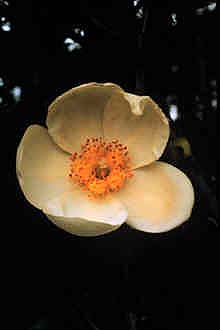Gordonia (plant)
 From Wikipedia the free encyclopedia
From Wikipedia the free encyclopedia
| Gordonia | |
|---|---|
 | |
| Gordonia lasianthus flower | |
| Scientific classification | |
| Kingdom: | Plantae |
| Clade: | Tracheophytes |
| Clade: | Angiosperms |
| Clade: | Eudicots |
| Clade: | Asterids |
| Order: | Ericales |
| Family: | Theaceae |
| Genus: | Gordonia J.Ellis |
| Species | |
| See text | |



Gordonia is a genus of flowering plants in the family Theaceae, related to Franklinia, Camellia and Stewartia. Of the roughly 40 species, all but two are native to southeast Asia in southern China, Taiwan and Indochina. The remaining species, G. lasianthus (Loblolly-bay), is native to southeast North America, from Virginia south to Florida and west to Louisiana; G. fruticosa is native to the tropical rainforests of Central and South America, from Costa Rica to Brazil.
They are evergreen trees, growing to 10–20 m tall. The bark is thick and deeply fissured. The leaves are alternately arranged, simple, serrated, thick, leathery, glossy, and 6–18 cm long. The flowers are large and conspicuous, 4–15 cm diameter, with 5 (occasionally 6-8) white petals; flowering is in late winter or early spring. The fruit is a dry five-valved capsule, with 1-4 seeds in each section.
The species are adapted to acidic soils, and do not grow well on chalk or other calcium-rich soils. They also have a high rainfall requirement and will not tolerate drought.
Some botanists include Franklinia within Gordonia, even though recent phylogenetic studies show that Franklinia's closest living relationship is with the Asian genera Schima and not Gordonia;[1] it differs in being deciduous and flowering in late summer, not late winter. The draft Flora of China account of Theaceae in China splits Gordonia into two genera, with G. lasianthus retained in Gordonia, and the Asian species transferred to Polyspora; this treatment is not yet widely accepted. Gordonia chrysandra may have anti-inflammatory medicinal properties.[2]
Species
[edit]There are about 40 species, including:
- Gordonia anomala
- Gordonia balansae
- Gordonia ceylanica
- Gordonia curtyana
- Gordonia fruticosa
- Gordonia hirta
- Gordonia hirtella
- Gordonia javanica
- Gordonia lasianthus
- Gordonia maingayi
- Gordonia multinervis
- Gordonia penangensis
- Gordonia scortechinii
- Gordonia shimidae
- Gordonia sinensis
- Gordonia singaporeana
- Gordonia speciosa
- Gordonia tagawae
- Gordonia taipingensis
- Gordonia villosa
- Gordonia wallichii
- Gordonia yunnanensis
Gordonia species from East Asia were transferred to Polyspora, including:[3]
- Polyspora acuminata
- Polyspora axillaris
- Polyspora chrysandra
- Polyspora hainanensis
- Polyspora kwangsiensis
- Polyspora longicarpa
- Polyspora tiantangensis
- Polyspora tonkinensis
Cultivation and uses
[edit]Several species of Gordonia are grown as ornamental plants for their flowers produced in winter when few other trees are in flower. They are however difficult to grow compared to the similar but generally smaller-growing camellias.
References
[edit]- ^ Prince, L. M. and C. R. Parks. 2001. Phylogenetic relationships of Theaceae inferred from Chloroplast DNA sequence data. Am. J. Bot. 88: 2309-2320.
- ^ CJ, Yang JZ, Shen ZF, Zhang DMFu HZ, Li.,"Potential Anti-inflammatory Constituents of the Stems of Gordonia chrysandra." J Nat Prod. 2011 Apr 7;
- ^ "Taxonomic Treatment of Chinese Polyspora Sweet(Theaceae)" (PDF). Journal of Tropical and Subtropical Botany. 中国科学院华南植物园. Retrieved 2009-02-13.[permanent dead link]